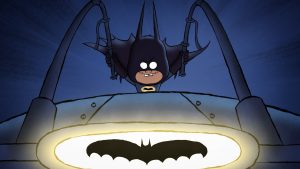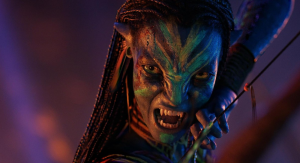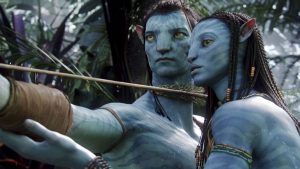
While both fans and detractors speak of superhero cinema like it began yesterday—or about a decade ago when the Marvel Cinematic Universe came into being—the truth is masked do-gooders are virtually as old as the movies themselves. One of the silver screen’s first great adventurers, Douglas Fairbanks in The Mark of Zorro (1924), was a major influence on Bob Kane and Bill Finger when they created Batman.
As long as there’s been source material with heroes doing daring deeds, there have been producers willing to take a gamble on putting them on the screen. For better or worse that process found its peak synthesis (or corporatized formula) in the 21st century. Yet there was a period just before then—ahead of folks figuring out they should adapt currently popular ‘90s comic book characters like Spider-Man, the X-Men, and the Hulk—where the studios went all in on resurrecting something older and, to ‘90s kids, truly ancient.
Yep, we’re talking about the pulp hero movie boom of the 1990s. This was the era when following the success of Tim Burton’s cultural atom bomb, Batman (1989), studio executives across Tinseltown got it into their heads that the appeal of Bruce Wayne wasn’t the character’s still thriving comic book series—which was beloved across multiple generations, from children to grandparents—but rather the retro mid-20th century Never Never Land Burton and production designer Anton Furst called Gotham City. The tortured but brilliant Furst won an Oscar for that movie, and Burton changed the idea of Gotham forever in the popular imagination while fusing the 1930s and ‘40s pulp stylings of Batman’s earliest years with ‘80s blockbuster excess and his own Gothic sensibilities.
In the aftermath, there was a flood of heroes that either sought to recreate that same kind of heightened artifice, or which wished to resurrect other once-popular relics of 1930s pop culture. Some of these were based on stories older than the Dark Knight, and others were modern attempts to reinterpret and revitalize that aesthetic. Almost all of them failed. And yet, somehow, they together form a weird little trend that’s become its own kind of nostalgic relic for a different Hollywood. These are the heroes that brought sexy art deco back.
Dick Tracy (1990)
The various attempts to get Dick Tracy off the ground preceded Burton’s Batman by nearly a decade. But if you don’t think Disney had Bat-Dollar signs in their eyes during the summer of 1990—when Dick Tracy had its own toy line, a tie-in album with Madonna, and even a McDonald’s “CrimeStoppers” sponsorship campaign (see the video above)—you must be as deluded as Big Boy Caprice. In fact, the reason the film features an underrated musical score by Danny Elfman, where he channeled his inner-George Gershwin with trumpeting early 20th century optimism, is because Disney sought Elfman out after his vampiric symphony triumph in Batman.
It’s worth noting the Dick Tracy character is also Batman’s elder, with the Chester Gould comic strip series about a yellow-hatted detective first appearing in the Detroit Mirror in 1931. Additionally, the filmmaker who finally had the clout to make the movie a reality after years of false-starts and various attached directors was Warren Beatty, a man who was born only a few short years after Dick in 1937. It was Beatty’s childhood affection for the character which caused the star to take the material to Disney and jettison the treatment of Walter Hill, the 48 Hrs. director who wanted something edgier and more violent. Instead Dick Tracy’s production design attempted to out-Batman Batman with a vibrant color palette of just seven colors. In this way it duplicated the bright simplicity of funny books and complemented the even more cartoonish (or some might say garish) makeup design of the films’ rogue’s gallery.
Dick Tracy was Disney’s big push of 1990, so when it grossed only $162 million (compared to Batman’s $412 million), the head of the motion picture division, Jeffrey Katzenberg, penned an infamous memo to his company where he castigated the studio and its peers for letting budgets on pricy high-concepts like Dick Tracy get out of hand. He argued studios should focus on smaller budgeted sure-things, advice the industry obviously ignored. But he perhaps had reason to be regretful. While the production design, costumes, musical score, and other craft elements are sublime in Dick Tracy, they serve a sum lesser than its parts.
Like many of Beatty’s vanity projects, the film lacks a strong dramatic or emotional center to justify its superficial indulgences, and Tracy might indeed be Beatty at his most indulgent. The filmmaker used his reputation to convince Al Pacino to mug his way through pounds of prosthetics as Big Boy Caprice; he got Dustin Hoffman to do a cameo under even more latex; and he convinced his current liaison, Madonna, to sing a half-dozen or songs written for the film by Stephen Sondheim, each grinding the pacing to a screeching halt. The result is a beautiful, moribund mess.
The Rocketeer (1991)
Unlike most of the characters and films on this list, the inspiration for The Rocketeer does not actually hail from the 1930s or adjacent decades. Instead the source material was always intended as a love letter to the pop culture of that period and what came directly after in the ’40s. That was the style and setting comic book writer and artist Dave Stevens chased when he created the character in 1982. And it almost immediately became a project of interest to Hollywood filmmakers.
Various producers and directors came and went in the ‘80s, and at one point there was even interest in making The Rocketeer as a low-budget black and white film, a la the ’30s film serials that inspired Stevens (or for that matter George Lucas). Disney eventually picked up the rights though, because Jeffrey Katzenberg saw the material as toyetic and perfect for merchandising. This cynicism did not appeal so much to Stevens, who lamented the material becoming more “kiddy” than his comics. Nonetheless, we’d argue the film is one of the finest on this list and has aged remarkably well.
Twenty years before he riffed on World War II serials in Captain America: The First Avenger, director Joe Johnston did more or less the same thing, but better, in The Rocketeer. The 1991 throwback achieves a true timelessness because it fully embraces the vernacular of ‘30s and ‘40s adventure flicks. There are in-camera stunts; a henchman modeled after Boris Karloff’s Frankenstein Monster; a yearning James Horner score; and even a brilliantly subversive inversion of ‘30s icon Errol Flynn by way of The Rocketeer’s secret Nazi spy villain, movie star Neville Sinclair (Timothy Dalton). But then almost all of the cast does a sterling job of evoking Saturday matinee awe, including Alan Arkin and Jennifer Connelly as essentially a WWII pin-up starlet.
Yet the film’s genuine nostalgia for ‘30s Hollywood chic and art deco décor did not catch on with audiences. The film grossed about $47 million in the U.S., barely better than its $40 million budget. Furthermore, according to Stevens, all those anticipated toys were shipped off to Midwest 99 cent stores in studio disgust after a weak opening.
The Shadow (1994)
Once again we have a pulp hero of the 1930s that predated Batman and who languished in Hollywood’s production hell during the 1980s; and again that changed rather quickly after the success of Burton’s Caped Crusader. Indeed, The Shadow, which is based on the pulp magazine character of the same name created by Walter B. Gibson and publishers Street & Smith, found itself gaining rapid momentum when a pre-Jurassic Park David Koepp was hired to adapt the character for modern sensibilities in 1990.
Unlike Burton or Batman scribe Sam Hamm, Koepp’s approach was more literal in how it went back to the material’s original context, He set The Shadow in 1920s New York City. Furthermore, there’s a Gothic and vaguely vampiric undertone to how our hero (a surprisingly debonair Alec Baldwin) does battle with a villain that felt straight out of problematic (i.e. racist) 1930s stereotypes.
Truthfully, the film’s plotting and structure is a mess. Koepp decided to lean in on one of the beloved lines from the 1930s The Shadow radio show, “who knows what evil lies in the hearts of man?,” and make the film’s proto-superhero morally ambiguous. He’s now a WWI veteran turned drug lord who must spend his life in penance after discovering the mystic arts of the Far East—and an epiphany about his own sins. In the hands of director Russell Mulcahy (Highlander), it’s fairly disjointed. Still, there are moments of pulpy delirium like when the Shadow first uses the power of hypnotism to cloud mobsters intent on throwing a man off a bridge; he similarly utilizes the trick to convince Tim Curry to hurl himself from a balcony. Tonally, it’s also nastier and more mean-spirited than Batman or Dick Tracy.
Universal Pictures hoped The Shadow would launch a film franchise, and invested in toy lines, a Super NES video game, and other merchandising events to make it exactly such an event. It wasn’t. The film grossed only $11 million after opening a few weeks following The Lion King. Still, the production’s 1980s false starts did inspire Sam Raimi (who attempted to do a modern retelling of The Shadow), into making the pulp-adjacent Darkman (1990).
The Phantom (1996)
Another hero of 1930s comic strips, The Phantom was first published by cartoonist Lee Falk as a nationally syndicated comic strip in 1936. The original Phantom was not one man, but many who across 20 generations share the title of “the Ghost Who Walks” while fighting against piracy and criminality in the deep jungles of Bengalla, a fictional African or Asian nation (depending on the telling). The original strips would jump between decades as one Phantom would pass his title onto his son, beginning in the 1500s. This caused outsiders and criminals alike to believe the Phantom was immortal.
Adapting such wild material to the screen—it’s essentially Tarzan meets the Shadow!—would always be difficult, and if it were ever to work, it probably would have been when Gremlins’ Joe Dante co-wrote a treatment with Jeffrey Boam (Indiana Jones and the Last Crusade) that Dante intended to direct. Dante told us in 2008 they planned for the film to be a spoof or winking homage of pulp hero tropes. But after Dante dropped out of the project, Paramount Pictures maintained plenty of those initial story beats and lines of dialogue with director Simon Wincer, who inexplicably played the material straight.
Whoever is at fault, The Phantom is such a tonally confused and misbegotten thing that it becomes almost charmingly confounding. A pre-Titanic Billy Zane is dashing enough as the 21st Phantom, who in 1938 must travel to New York City to hunt down his father’s murderer. The film also deals with flirty all-women sky pirates (led by a pre-Zorro Catherine Zeta-Jones) and incredibly problematic Southeast Asian sea pirates, both of which spring from the comic strip. The Phantom likewise races an evil millionaire (Treat Williams) to obtain the Skulls of Touganda, which along with the Phantom’s Skull Ring represent supernatural flourishes added to the movie, presumably to emulate Indiana Jones.
None of it works! The sight of Zane in a bright, skin-tight purple onesie as he rides a white horse through real Thai jungles clashes violently against Williams’ grotesquely camp performance; and the primitive CG-magic skulls in retrospect should’ve warned George Lucas to stay away from their crystal cousins a decade later. The movie grossed $23.5 million against its $45 million budget.
The Mask of Zorro (1998)
The interesting thing about Zorro is that he technically is a pulp hero and not. Just as he is arguably a superhero and not; he’s even a Western icon despite featuring in tales usually set well before the mass westward expansion of the U.S. Zorro is whatever you want him to be, and in 1998 that meant he was a Steven Spielberg cash cow that drew on the character’s swashbuckling origins, Western flavorings, and a superhero aesthetic turned up to the level of “sexy.” (It did star Antonio Banderas, after all.)
Zorro was created by pulp writer Johnston McCulley in 1919 for the novel The Curse of Capistrano, which was originally published in five parts in the pulp magazine All-Story Weekly. That, in turn, became the basis for the 1924 Douglas Fairbanks movie that made Zorro a pop culture icon—one who would inspire future pulp comic heroes The Shadow and Batman. So Zorro is as old as the various genres he dances between.
In ’98 though, producer Spielberg and director Martin Campbell threaded a needle many other filmmakers doing period piece superhero movies could not. As Zorro was the original do-gooder who wore a mask and had a secret identity, many of those beats are still in The Mask of Zorro, but it felt fresh when the story became essentially a tale of legacy with one Zorro (Anthony Hopkins) passing the mantle on to another who seemed unready (Banderas). The film had the classy swashbuckling verve of a 1930s Errol Flynn movie, but the style and panache of a modern action movie working from an actually finished script. It’s old-fashioned and modern all at once, particularly whenever Banderas crossed blades with Catherine Zeta-Jones, who became a star overnight as the younger Zorro’s romantic foil/sparring partner.
The Mask of Zorro was a hit in 1998, grossing $250 million off a $95 million budget. It’s therefore curious that the film has not enjoyed the lasting cultural footprint of other popular ‘90s blockbusters, including one more below on this list. Because unlike most PG-13 summer tent poles of the late ‘90s, The Mask of Zorro has aged quite nicely. It relies on practical stunt work and vigorous fight choreography, something that pops against the CG-obsession of its contemporaries, which were thrilled to include now fairly unconvincing giant CG lizards, asteroids, or even mechanical spiders. It also features a rock solid screenplay by Ted Elliott and Terry Rossio (Aladdin, the first Pirates of the Caribbean), strong performances, witty dialogue, and another pitch perfect James Horner score. It’s a shame it seems to have faded in the collective memory.
The Mummy (1999)
We end with a film very much derived from early 20th century pulps, although it was drawing on a different muse than many of the Batman-chasing projects listed above. Instead writer-director Stephen Sommers unapologetically drew from Steven Spielberg and George Lucas’ beloved dance with 1930s adventure serials, Indiana Jones. Sommers apparently even pitched his version of The Mummy remake to Universal Pictures as “kind of Indiana Jones or Jason and the Argonauts with the mummy as the creature giving the hero a hard time.”
Still, a different type of pulp story was being extracted by Sommers, and it wasn’t drawn strictly from Dr. Jones. Consider The Mummy’s 1920s setting. Like a certain number of pulp superhero failures earlier in the ‘90s, The Mummy is a period piece, this time with events starting in 1923. That’s one year removed from the discovery of the Tomb of King Tutankhamen (King Tut). The first and only pharaoh discovered with his afterlife treasures intact, Tut captured the global imagination after WWI and led to a renewed and voracious American brand of Egyptomania. The release of Universal’s original The Mummy a decade later in 1932 was the crest of this wave, but many a pulp story, magazine, and comic had already featured undead mummies and curses out to get the hero.
The Mummy (1999) taps into that with a pulpy hero a lot like Indiana Jones and all the other descendants of H. Rider Haggard’s Alan Quartermaine. Yet to Sommers and The Mummy’s credit, those influences didn’t feel creaky or out-of-touch—a phenomenon that bedeviled all the other Indy knockoffs in the ‘80s, including Richard Chamberlain’s take on Quartermaine. Rather Brendan Fraser’s shrewd casting as Rick O’Connell gave a hip, faintly modern himbo energy to The Mummy. And when paired with Rachel Weisz’s charisma as his erudite and scholarly soulmate, The Mummy became an unlikely romantic adventure romp.
The movie really does wear a lot of hats: action, romance, even a few stabs at horror in lieu of its 1932 monster movie source material. Not all of them work, and the emphasis on showing off computer-generated scarabs and mummy armies has aged a lot worse than the sequences which just feature Fraser and Weisz on camel-back. But the movie not only was a success in ’99, grossing $417 million off an $80 million budget, but it has stood the test of time as an undying classic.
The post The Pulp Hero Movies of the ‘90s: That Weird Time Art Deco Style Came Back to Hollywood appeared first on Den of Geek.






